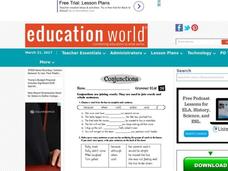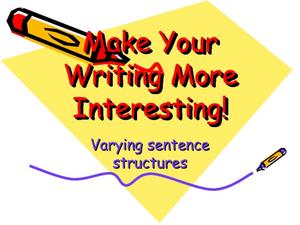Curated OER
Introduction Paragraph
Key parts of an introductory paragraph (grabber sentence, connecting information, thesis) are highlighted in a presentation that uses color-coded sample paragraphs to illustrate how these parts combine to form a complete opening paragraph.
Study Champs
Interjection
Wow! Yes! Great! Practice identifying interjections! After reading through a definition and example of interjection, class members underline the interjections in each sentence.
Curated OER
Conjunctions
In this grammar worksheet, students choose a correct conjunction to complete six sentences. Students write sentences by combining given groups of words. Students combine sentences by using a conjunction.
Curated OER
Pesky Punctuation 1: The Comma
From the purpose of punctuation to its proper uses, guide your learners with this presentation. Great visuals dissect sentences to show where a comma belongs and the different parts of a sentence. Help your class use commas only when...
Curated OER
Similes
Similes are a great way to get your writers thinking about descriptive details. They read a brief explanation which covers clichés and the general wording of a simile. Then, learners try a few on their own. First, they complete nine...
K12 Reader
Pronouns as Adjectives
When is a pronoun also an adjective? Elementary learners look through ten sentences to determine which ones include pronouns used as adjectives.
Curated OER
Name It! - Nouns
Young readers practice identifying nouns. This interactive resource goes over the the three categories that nouns fit into, then has them click on the words they think are nouns in sentences contained in each slide. If they get it right,...
Curated OER
Outlines and Organization: Sample Outline
Provide your essay writers with a sample essay outline. Richly detailed, this two-page handout not only describes the necessary parts of an outline, but also explains the purpose of each section. A model outline is also included.
Florida Center for Reading Research
Vocabulary: Word Meaning, Dictionary Digs
Young scholars dig through dictionaries to uncover the wealth of information they provide. Using the included graphic organizer, children learn about target words by finding their parts of speech, pronunciation, definition, synonyms, and...
Curated OER
Excessive Nominalizations
Eliminate unnecessary nominalizations from your middle schoolers' writing! After reviewing a reference page for the -tion ending (and when it can be excessive in writing), students rewrite eight sentences to change nominalizations to a...
Curated OER
Conjunctions Worksheet
Help your early elementary learners write complex or compound sentences using conjunctions. They use the listed conjunctions to combine five different sentences. They then use the space provided to compose a complex sentence of their own.
Curated OER
Verbs
Ready, set, action words! It's all about verbs as scholars examine 12 words and write down the six that are action words. They use the six words to complete six sentence frames, each accompanied by an image to assist grammarians in...
Curated OER
Proper Nouns
Use this worksheet to help your class identify proper nouns. They circle the proper nouns in 16 sentences. Answer key is provided.
Curated OER
Conquering the Comma
Thoroughly review where to put commas: after an introductory clause, before a coordinating conjunction, around nonessential phrases, etc. Furthermore, avoid comma splices by adding a conjunction or semicolon or by starting a new sentence...
Curated OER
Phrases as Fragments
A sentence needs to have a subject and a verb. Although your kids know this, fragments often sneak their way into essays and homework assignments. Give your class a review session with this assignment. First, have them read the...
Curated OER
Subject-Verb Agreement Context Exercises
Focus on verb agreement with this clear, concise instructional activity. Various subject-verb combinations and sentence examples prompt learners to choose the correct verb to fill in the blank. A great tool and handy guide for this area...
Curated OER
Make Your Writing More Interesting
Teach your class how to improve their writing. This resource walks learners through the keys to good writing. It addresses the need for complex sentences, the use of different ways to open a sentence, and the importance of varying the...
Curated OER
Subjects and Predicates
Get ready for some laughs with subjects and predicates! These worksheets feature nine sentence frames each, half in need of a subject and half a predicate. A word bank holds phrases students can use to complete these sentences, and there...
Curated OER
Editing
Take young authors through the writing process with a worksheet on editing. Given three sentences with unnecessary words, pupils cross out the extra words and write the rest of the sentence in the space provided. An excellent way to...
Curated OER
Verb Tenses
Discover how to use proper verb tenses with context clues. Five sentences help first graders decide if they should use -ed or -ing to end simple verbs. Each sentence provides context clues to indicate the time. Use the resource in...
Curated OER
Possessive Adjectives
You could use this resource with your young native English speakers or your English language learners. They practice using possessive adjectives like my, your, his, her, its, our, and their. First they study a chart that compares...
Curated OER
Describe common actions and objects in specific and general language
Having a diverse and well-developed vocabulary make for both good readers and good writers. The class discusses basic grammar, such as nouns, verb, and adjectives. They then view a series of pictures and work as a class to create simple...
Curated OER
Predicate Adjectives
Focus on identifying predicate adjectives in sentences. Use the first sheet to review adjectives and predicate adjectives. Several examples are provided along with brief explanations. Then, move on to the second sheet to put this...
Curated OER
Connectives
Using connectives and conjunctions is an easy way to vary sentence structure. Third graders review the given connectives, then use them to combine two simple sentences. The second section allows learners to use more words and phrases as...
Other popular searches
- Labeling Parts of Sentences
- Telling Parts of Sentences
- Naming Parts of Sentences
- Action Parts of Sentences
- Sentences Parts
- Misplaced Parts of Sentences
- Name Parts of Sentences
- Sentences Parts of Speech
- Reconstruct Parts of Sentences























